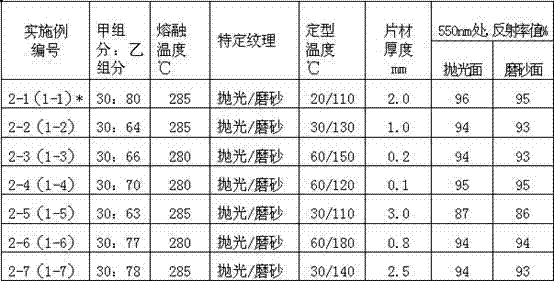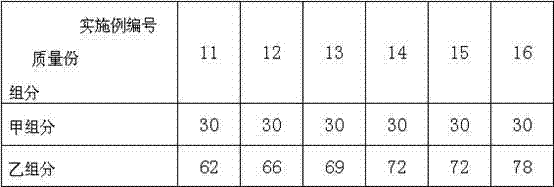Composite salivate method light reflection sheet and manufacturing method thereof
A technology of light reflection and salivation method, applied in chemical instruments and methods, diffusing elements, flat products, etc., can solve the problems of high cost, time-consuming and complicated, and achieve the effect of high reflectivity
- Summary
- Abstract
- Description
- Claims
- Application Information
AI Technical Summary
Problems solved by technology
Method used
Image
Examples
Embodiment 1-1
[0055] Preparation of component A: Mix 6 parts of silicon dioxide (average diameter 13 μm), 10 parts of titanium dioxide (average diameter 7 μm), 8 parts of barium sulfate (average diameter 7 μm) and 35 parts of polyvinylidene fluoride in the silo, Through a twin-screw extruder, melt blending, extrusion and granulation are performed at 170° C., dried to remove moisture, and then used for later use.
[0056] Preparation of component B: dry-mix 50 parts of polyester resin and 3 parts of compatibilizer polybutylene terephthalate and polyethylene glycol copolymer and set aside.
[0057] Preparation of component D: dry mix 0.05 part of organic ultraviolet absorber methyl o-hydroxybenzoate and 0.5 part of antistatic agent polyether ester amide and set aside.
[0058] Preparation of component C: Dry mix 1 part of component C with 100 parts of polyester resin and set aside.
Embodiment 1-2
[0060] Preparation of component A: Mix 5 parts of inorganic particle titanium dioxide (average diameter 22 μm), 15 parts of magnesium sulfate (average diameter 6 μm) and 20 parts of polyvinylidene fluoride in the silo, and pass through a twin-screw extruder at 175 Melt blending, extruding and granulating at ℃, drying and removing moisture for later use.
[0061] Preparation of component B: dry-mix 60 parts of polyester resin and 10 parts of compatibilizer polybutylene terephthalate and polytetramethylene glycol ether copolymer and set aside.
[0062] Preparation of component D: dry-mix 0.35 parts of organic ultraviolet absorber 2,4-dihydroxybenzophenone and 2.5 parts of antistatic agent methoxypolyethylene glycol and methacrylate copolymer and set aside.
[0063] Preparation of component C: Dry mix 5 parts of component D and 100 parts of polyester resin evenly for later use.
Embodiment 1-3
[0065] Preparation of component A: Mix 11 parts of silicon dioxide (average diameter 14 μm), 25 parts of barium sulfate (average diameter 4 μm) and 35 parts of polyvinylidene fluoride in the silo, and pass through a twin-screw extruder at 180 Melt blending, extruding and granulating at ℃, drying and removing moisture for later use.
[0066] Preparation of component B: dry-mix 70 parts of polycarbonate resin and 15 parts of compatibilizer polybutylene terephthalate and methoxypolyethylene glycol copolymer and set aside.
[0067] Preparation of component D: dry-mix 0.85 parts of organic ultraviolet absorber 2-(2'-hydroxy-5'-methylphenyl)benzotriazole and 4.5 parts of antistatic agent methoxypolyethylene glycol and set aside.
[0068] Preparation of component C: dry-mix 4.5 parts of component D and 100 parts of polycarbonate resin and set aside.
PUM
| Property | Measurement | Unit |
|---|---|---|
| Diameter | aaaaa | aaaaa |
| Melting range | aaaaa | aaaaa |
| Thickness | aaaaa | aaaaa |
Abstract
Description
Claims
Application Information
 Login to View More
Login to View More - R&D
- Intellectual Property
- Life Sciences
- Materials
- Tech Scout
- Unparalleled Data Quality
- Higher Quality Content
- 60% Fewer Hallucinations
Browse by: Latest US Patents, China's latest patents, Technical Efficacy Thesaurus, Application Domain, Technology Topic, Popular Technical Reports.
© 2025 PatSnap. All rights reserved.Legal|Privacy policy|Modern Slavery Act Transparency Statement|Sitemap|About US| Contact US: help@patsnap.com



